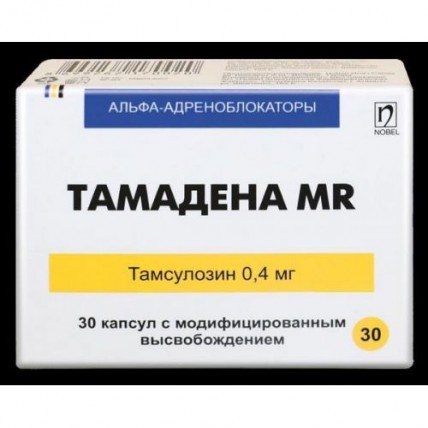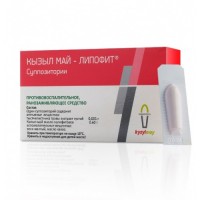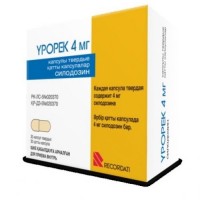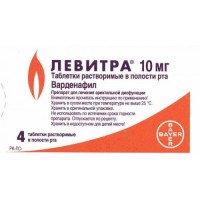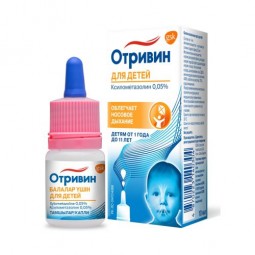Tamada MR 0,4 30s mg modified-release capsules
- $24.10
The instruction for medical use of TAMADENA MR medicine the Trade name of TAMADENA MR the International unlicensed name Tamsulozin Lekarstvennaya the Capsule form with the modified release, 0.4 mg Structure One capsule contains active agent - a tamsulozin a hydrochloride of 0.400 mg, excipients: sodium alginate, mix of methacrylic acid and kopolimer of ethyl acrylate (1:1), glitserol dibegenat, maltodextrin, sodium lauryl sulfate, polyethyleneglycol (makrogol) 6000, polysorbate 80, sodium hydroxide, emulsion of a simetikon of 30%, silicon dioxide colloidal (aerosil 200) structure of a cover of the body and lid of capsules: the titan dioxide (E 171), ferrous oxide yellow (E172), ferrous oxide red (E172), gelatin the Description Solid gelatin capsules of the 2 size with the opaque light orange body and a lid. Contents of the capsule granule of white or yellowish color. Pharmacotherapeutic group Drugs for treatment of urological diseases. Drugs for treatment of a benign hypertrophy of a prostate. Alpha adrenoblockers. Tamsulozin ATX G04CA02 Code Pharmacological Pharmacokinetics Absorption properties. Tamsulozin is soaked up in a small intestine, the bioavailability of drug is close to 100%. Absorption of a tamsulozin decreases if to take the drug right after food. The uniformity of absorption can be maintained at constant use of a tamsulozin after meal, in one and too time. Pharmacokinetic indicators of a tamsulozin have linear character. The maximum concentration (Cmax) in blood plasma is reached approximately in 6 hours after reception of a single dose of a tamsulozin, the accepted ambassador of food. Equilibrium concentration is reached in 5 days of reception of a course dose, in this condition of Cmax is two thirds higher than Cmax after reception of one dose of drug. Though it was shown only at elderly, but the same result can be expected also at young patients. There are significant changes in level of a tamsulozin in blood plasma among patients after single and repeated introduction. Distribution. In a human body, tamsulozin approximately for 99% contacts proteins of plasma, the volume of distribution of drug is not big (about 0.2 l/kg). Biotransformation. Tamsulozin has low effect of primary passing, is metabolized slowly. The most part of a tamsulozin is present at blood plasma in not changed look. Drug is metabolized in a liver. Any of metabolites has no activity exceeding activity of the most active ingredient of drug. Removal. Tamsulozin and his metabolites are mainly allocated with urine, at the same time the share of not changed drug makes about 9%. Elimination half-life of a tamsulozin makes about 10 hours if it was accepted after a meal and 13 hours - in an equilibrium state. The pharmacodynamics Tamsulozin is a selection competitive inhibitor postsynaptic α1-адренорецепторов, drug has affinity to α1A and α1D to subtypes, linking of a tamsulozin with these receptors relaxes unstriated muscles of a prostate and an urethra. Tamsulozin increases the maximum flow rate of urine. Weakening expressiveness of obstruction by decrease in a tone of smooth muscles of a prostate and an urethra, tamsulozin reduces depletion symptoms. Besides, drug reduces expressiveness of filling symptoms in which development an important role is played by instability of a bladder. These effects concerning symptoms of an ischuria and disturbance of urination remain at long therapy therefore need of surgical intervention can be considerably delayed. Alpha 1 - blockers due to decrease in peripheric resistance can reduce arterial blood pressure. However clinically significant lowering of arterial pressure was not observed. Indications - treatment of dysuric disorders in the benign hyperplasia of a prostate (BHP) the Route of administration and doses Is recommended to men at the age of 45-75 years. To accept on one capsule a day after a breakfast or after the first meal. The capsule is swallowed entirely, washing down with water, it is not recommended to chew or break it as it can affect drug release speed. Duration of treatment is defined by the doctor individually depending on a clinical condition of the patient. Patients with a renal failure of Dose adjustment it is not required. Patients with an abnormal liver function In abnormal liver functions easy and moderate severity of dose adjustment is not required Side effects Often (& gt, 1/100, & lt, 1/10) - dizziness - disturbance of an ejaculation Infrequently (& gt, 1/1,000, & lt, 1/100) - a headache - tachycardia, - an asthenia - orthostatic hypotension - rhinitis - nausea, vomiting, a constipation, diarrhea - rash, a skin itching, a small tortoiseshell Seldom (& gt, 1/10,000, & lt, 1/1,000) - faints - a Quincke's disease Very seldom (& lt, 1/10,000) - a priapism - Stephens-Johnson's syndrome during operation for a cataract was noted development of a syndrome of intraoperative instability of an iris of the eye of an eye (syndrome of a narrow pupil) that was noted in post-marketing observations. The contraindication - hypersensitivity to active component of drug or excipients - orthostatic hypotension (including in the anamnesis) - the profound liver failure - with care – a heavy renal failure (clearance of creatinine of ˂10 ml/min.) - children's and teenage age up to 18 years Medicinal interactions was Not noted adverse medicinal interactions at use of a tamsulozin along with atenolol, enalapril, nifedipine or theophylline. The concomitant use of drug with Cimetidinum leads to increase in concentration of a tamsulozin in blood plasma, and reception with furosemide - to decrease in plasma concentration of drug, however, concentration remain within acceptable level. In the conditions of in vitro with use a liver microscope (reflect the processes happening taking into account P450 cytochrome isoforms) interaction at the level of hepatic metabolism with amitriptyline, salbutamol, glibeklamidy and finasteridy was not revealed. However, diclofenac and warfarin can increase the clearance rate of a tamsulozin. At co-administration with the drugs reducing arterial blood pressure, for example, drugs for the general anesthesia or other antagonists α1-адренорецепторов, increase in their hypotensive action can be noted. Simultaneous use of a tamsulozin with CYP3A4 inhibitors can lead to strengthening of effect of a tamsulozin. Co-administration of a ketokonazol (known strong CYP3A4 inhibitor) led to increase in AUC and Cmax of a tamsulozin respectively in 2.8 and 2.2 times. Tamsulozin should not be applied in a combination with the expressed CYP3A4 inhibitors at patients – slow metabolizator with CYP2D6 phenotype. Tamsulozin it is necessary to use with care in a combination with the expressed and moderate CYP3A4 inhibitors. Co-administration of a tamsulozin with paroksetiny, the expressed CYP2D6 inhibitor, was followed increase in Cmax and AUC of a tamsulozin respectively in 1.3 and 1.6 times, however these changes are regarded as clinically not significant. Special instructions As well as when using other antagonists α1-адренорецепторов, in some cases treatment of TAMADENA MR can be followed by a lowering of arterial pressure, as a result, in rare instances perhaps development of an unconscious state. At the first symptoms of orthostatic hypotonia (dizziness, weakness) the patient should pass into a sitting position or lying before disappearance of symptoms. Before an initiation of treatment of TAMADENA MR it is necessary to perform examination of the patient for an exception of other states, the followed similar symptoms with a benign hyperplasia of a prostate. Before an initiation of treatment and subsequently through regular intervals it is necessary to conduct a manual rectal research and if it is necessary, definition of prostatspetsifichesky antigen (DOG). Treatment of patients with a heavy renal failure (clearance of creatinine & lt, 10 ml/min.) has to be performed with care as researches at such patients were not conducted. At the certain patients who were receiving or earlier accepting tamsulozin at operational treatment concerning a cataract or glaucoma the intraoperative syndrome of a flabby iris (Intraoperative Floppy Iris Syndrome, IFIS), option of a syndrome of a narrow pupil was observed. Existence of IFIS can increase risk of complications from eyes in time and after operation. From experience it is known that there can be useful a cancellation of a tamsulozin of a hydrochloride in 1-2 weeks prior to operation, but effects of such cancellation of therapy are not established yet. Also it was reported about development of IFIS in the patients who stopped reception of a tamsulozin long before operation. At patients to whom carrying out operational treatment of a cataract or glaucoma is planned, are not recommended to begin therapy of a tamsulozin with a hydrochloride. In process of a preparation for surgery the surgeons and ophthalmologists have to specify, accepts or whether the patient to whom operational treatment of a cataract or glaucoma is planned, tamsulozin accepted earlier to be ready to treatment of IFIS in case of its development during operation. Pregnancy and the period of a lactation Drug is intended only for treatment of men. Features of influence of medicine on ability to run the vehicle or potentially dangerous mechanisms of the Research of influence on ability to driving of the car and to control of mechanisms were not carried out. However, patients have to show care, in connection with a possibility of development of dizziness. Overdose Symptoms: heavy arterial hypotension. Treatment: in case of overdose it is recommended to turn the patient to horizontal position and to hold the events directed to maintenance of function of a cardiovascular system (restoration of arterial blood pressure), gastric lavage, administration of activated carbon and osmotic depletive, such as sodium sulfate. In the absence of effect it is necessary to enter the substances increasing the volume of the circulating blood and if necessary, vasoconstrictors. Are necessary assessment of function of kidneys in dynamics and performing maintenance therapy. As drug substantially contacts proteins of blood plasma, the hemodialysis is ineffective at overdose of a tamsulozin. The form of release and packing On 10 capsules place in blister strip packaging from a transparent film of polyvinylchloride and printing aluminum foil. On 2, 3 or 5 blister strip packagings together with the instruction for medical use in the state and Russian languages put in a cardboard pack. To Store storage conditions at a temperature not above 25 °C, in the dry, protected from light place. To store out of children's reach! 2 years not to use a period of storage after expiry date. Prescription status According to the prescription the Producer/packer Nobel Ilach Sanai ve A.Sh. Tidzharet, Turkey the Holder of the registration certificate of JSC Nobel Almatinskaya Pharmatsevticheskaya Fabrika Republic of Kazakhstan Almaty, Shevchenko St., 162 E. The address of the organization accepting in the territory of the Republic of Kazakhstan claims from consumers on quality of products (goods) and responsible for post-registration observation of safety of medicine: JSC Nobel Almatinskaya Pharmatsevticheskaya Fabrika Republic of Kazakhstan, Almaty, Shevchenko St. 162 E. Phone number: (+7 727) 399-50-50 Fax number: (+7 727) 399-60-60
To Develop the e-mail address of nobel@nobel.kz
To Develop the e-mail address of nobel@nobel.kz
